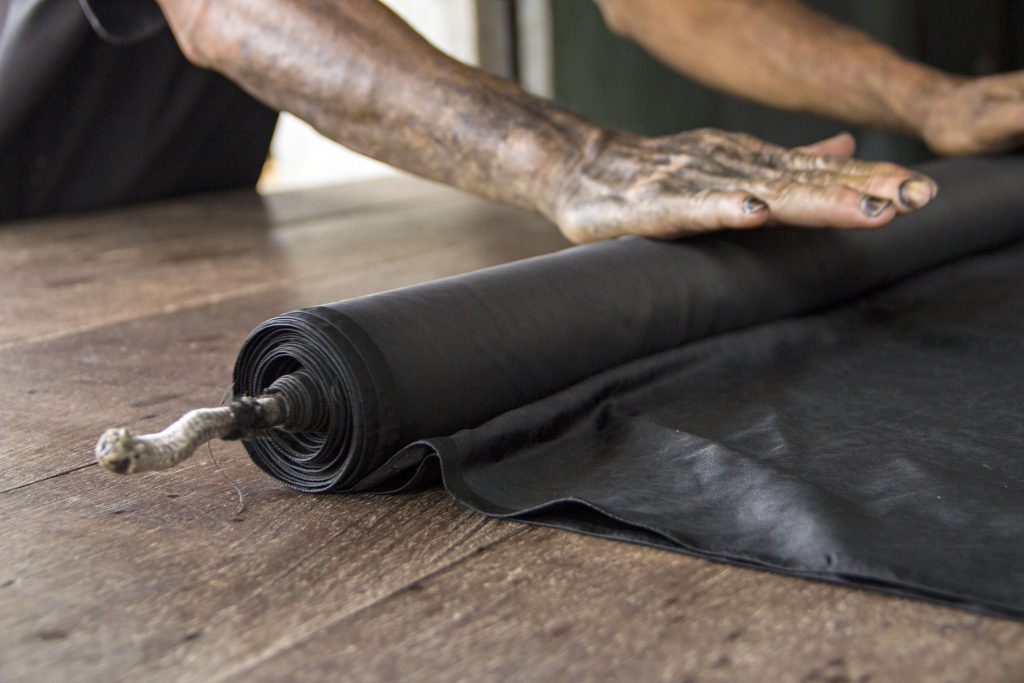Story: M. Hang
Legendary shimmering My A silk is being reintroduced to the modern fashion world in designs by Cong Tri.

The lustrous My A silk produced has long been a huge source pride for the Tan Chau Silk Region in southern An Giang Province. My A silk is famously soft and smooth to the touch, cool in the summer and warm in the winter, and perfumed with the rustic scent of mac leua fruit used to dye the fabric its signature shimmering black.
However, as the tumultuous currents of the 20th century swept through Vietnam, the product faded into obscurity and by the early 1980s, the last producer specializing in silk, Mr. Tam Lang, had to close down his business.
It was not until the 1990s that his family revived the old weaving business. Tan Chau silkworms had been brought to extinction, and My A silk was made by the choicest natural thread from by silkworms from Fuji, Japan, for a premium quality good enough to be used by global couture brands of the world.
The weaving process of My A silk scrolls is complex and requires hard work, experience and patience. Each loom is assigned to tens of thousands of gossamer threads and weavers are unable to take their eyes off the work to avoid any mistakes, so that the entire bolt of silk seems to be woven out of a single thread. Once finished, the silk is boiled to rid of the sap of silkworms and then dyed. The black color of My A silk is derived from mac leua fruit; no one knows exactly when this fruit began to be used, but it adds an enchanting and one-of-a-kind quality to the fabric. One hundred kilograms of ground mac leua can yield enough sap to dye a 20-meter bolt of silk. The roll is dipped in a barrel of mac leua sap bit by bit and then dried under the dawning sun: Silk clashes with the intense sun, and languishes in the heat; it can just be dried on the lawn, under the gentle sun and natural breezes.

The silk requires six layers to be dyed, and the first layer alone takes nine days with 27 dying turns repeatedly. Between dyeing and drying, the silk is washed in the Mekong River to get rid of the residual sap on the surface. From the fourth layer onwards, the silk is thrashed to break its texture and have mac leua sap deeply permeate the threads so that the overall surface is durable, lustrous and beautiful. Only highly experienced dyers are allowed to undertake this step.
The process of making the silk is as painstaking as working with lacquer, and with such a refined result so that My A organza is sometimes called “lacquer silk.” The entire dyeing process takes up to 45 days under sunny condition, including 45 dying turns, 20 washing turns and 10 thrashing turns. Weaving included, it takes 4 months to produce a roll of My A silk that is lustrous, velvety, mythically black and even more shimmering if used, since it absorbs the sun’s heat, caressing natural breezes and the soft cascading of river water on the surface. As a result, each piece of silk seems to reflect upon both time and space that conceived it.

Previously, the áo dài or bà ba tunics made with My A silk were treasures owned exclusively by ladies from wealthy families. Now revived, My A silk is still a much-coveted fabric, as the process proves so meticulous that only the most experienced craftsmen, steeped in the traditions of their ancestors, can produce it.
For nearly 20 years, Hanoia – the first couture lacquer brand of Vietnam – has been committed to helping craftsman Tam Lang and his son, Nguyen Huu Tri, to preserve the craft of My A silk. In an effort to help preserve and promote endangered crafts and their traditional cultural values, in the past few years, Hanoia has brought My A organza to famous couture fashion houses worldwide and marketed it as a unique material, which is as soft as silk and durable and lustrous as leather.
The fabric has inspired new and highly creative works from top designers. Cong Tri, who was just included as one of the 100 outstanding contemporary fashion designers in the world, was the first too work with Hanoia to honor this luxurious material. The lustrous and shimmering quality of the silk was taken advantage of by Cong Tri with frills, plaits and ruffles which help reflect a varying spectrum of black as the wearer moves. The plaiting techniques deployed in his designs require seamstresses to produce beautiful twists that mirror the sophistication of the silk’s weavers and dyers. At the same, time, ruffled silk shirts and tunics breathe modernity into this centuries-old and long gone fabric. My A silk has also been boldly applied to accessories such as clutches and bags, of which the original black is supplemented with brand new colors also yielded out of organic ingredients.
Today, legendary My A silk is thriving in a contemporary fashion context. Its mesmerizing black shade can be employed to create new styles with the tangible luxury of the finest silk product of Vietnam.










